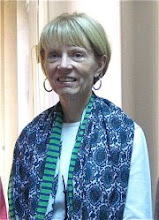Chellah
 Today I visited the oldest settled area of Rabat, known as Chellah. It's on the banks of the Oued Bou Regreg (the river separating Rabat and Salé) and was probably founded by Phoenicians in anywhere from the eighth to third century BC. Later, the Romans took over (40 AD) and established the Roman settlement of Sala Colonia. Roman ruins have their allure; but I thought the Merenid ramparts, walls, and triumphal gates the most interesting. In fact, one of the most astonishing aspects of a visit to the Chellah is the number of stork nests on and around the mosque's minaret. Another is the number of couples who visit a pool with eels, toss coins into it, and sit in contemplative silence on its edge. Some say women toss eggs into the pool for fertility. The eels often retreat to the farther reaches of the pool shaded by an arched cover. I did see a few, however. Nearby, just outside the zaouia (sanctuary), a woman was feeding at least 30 cats. Cats roamed and slept freely throughout the Cellah. The Cellah was used by the Merenids who conquered Fes in 1248, as a spiritual retreat. Apparently today, cats help to add to that atmosphere and perhaps receive a bit of baraka (blessing) themselves. A few roosters, supposedly not to be forgotten, also made their appearance in the area around the basin. Not far away is a marabout's tomb, topped with a small white koubba (cupola). Three aspects of Moroccan religion present in view of each other: Sunni Islam, Sufism, and traditional beliefs. From a platform in the gardens, you can view the massive walls and look out over the River Bou Regreg to see cultivated fields below and cliffs across the river. I visited the Chellah on a Friday at noon, when most Moroccans were at prayer and most tourists off having lunch. I was able to experience the site at its most serene.
Today I visited the oldest settled area of Rabat, known as Chellah. It's on the banks of the Oued Bou Regreg (the river separating Rabat and Salé) and was probably founded by Phoenicians in anywhere from the eighth to third century BC. Later, the Romans took over (40 AD) and established the Roman settlement of Sala Colonia. Roman ruins have their allure; but I thought the Merenid ramparts, walls, and triumphal gates the most interesting. In fact, one of the most astonishing aspects of a visit to the Chellah is the number of stork nests on and around the mosque's minaret. Another is the number of couples who visit a pool with eels, toss coins into it, and sit in contemplative silence on its edge. Some say women toss eggs into the pool for fertility. The eels often retreat to the farther reaches of the pool shaded by an arched cover. I did see a few, however. Nearby, just outside the zaouia (sanctuary), a woman was feeding at least 30 cats. Cats roamed and slept freely throughout the Cellah. The Cellah was used by the Merenids who conquered Fes in 1248, as a spiritual retreat. Apparently today, cats help to add to that atmosphere and perhaps receive a bit of baraka (blessing) themselves. A few roosters, supposedly not to be forgotten, also made their appearance in the area around the basin. Not far away is a marabout's tomb, topped with a small white koubba (cupola). Three aspects of Moroccan religion present in view of each other: Sunni Islam, Sufism, and traditional beliefs. From a platform in the gardens, you can view the massive walls and look out over the River Bou Regreg to see cultivated fields below and cliffs across the river. I visited the Chellah on a Friday at noon, when most Moroccans were at prayer and most tourists off having lunch. I was able to experience the site at its most serene.On a different note, a cartoon in the Moroccan newspaper, L'Economiste (9/7), has a Lebanese teacher thinking of asking his students to share their summer vacation experiences, until he notices the signs denoting a death in the family on their desks. I don't think the average American would symphathize as deeply with the Lebanese people as do Moroccans. Given a world view shaped overwhelmingly by religion, most Moroccans also view Hassan Nasrullah, the leader of Hizbullah, as a hero.


0 Comments:
Post a Comment
<< Home